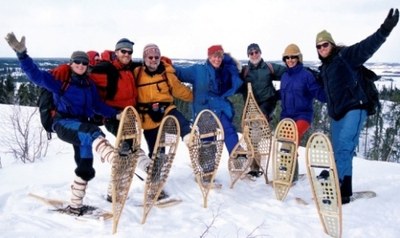
Field trip: Basic Snowshoeing Course
Basic Snowshoeing Field Trip - Commonwealth Basin
Field trip for the Foothills Basic Snowshoeing Course. Completion of one field trip is required for graduation from the course.
- Sun, Feb 4, 2024
- Foothills Snowshoeing Committee [INACTIVE]
- Snowshoeing
- Basic
- Adults
- Moderate
- Casual
- Mileage: 5.0 mi
- Elevation Gain: 700 ft
- 4 (9 capacity)
- 1 (4 capacity)
- Sat, Oct 14, 2023 at 9:28 AM
- Fri, Feb 2, 2024 at 5:00 PM
- Cancellation & Refund Policy
- iCal Google
In this field session you will learn and practice the basics: balance, maneuvering on snowshoes, going up hill, side-hill and handling downhills.
Group will meet at Snoqualmie Summit, off Exit 52. Details tyo be provided. Carpoolers can meet at Issaquah Transit center, I-90 exit 15, to self-organize carpools to the summit
Badges
students will earn:
Commonwealth Basin
-
Green Trails Snoqualmie Pass No. 207
USGS Snoqualmie Pass - See full route/place details.
Required Equipment
A limited number of MSR snowshoes will be available for students to rent. If you're interested in this option, please contact the leader for more information.

TEN ESSENTIALS
Map (provided to you), compass, sunglasses and sunscreen, extra clothing, emergency shelter, headlamp/flashlight, first-aid supplies, fire starter, matches, knife, extra food and water. Sun protection is a must. Snow reflection is highly damaging to eyes; UV damage and sunburns are common if proper protection is not used.
CLOTHING & EQUIPMENT
- Winter boots (insulated)
- Gaiters
- Snowshoes
- Backpack (large enough for all winter gear)
- Ski / trekking poles with snow baskets
- Clothing layers (adjustable to your activity level and the weather - No cotton)
- Base layer: Wicking liner socks, glove liners, synthetic or wool long underwear that wicks away moisture, insulates well and dries quickly. Lightweight or midweight versions are available; pick a thickness based on the temperature and your activity level. A zippered top lets you adjust body heat as you stop and go.
- Insulating layer: Wool socks, synthetic soft-shell pants, Polartec® or Primaloft® polyester mid-layer jackets. "Active Insulation" clothing makes a good mid-layer since it retains heat when wet and breathes as you exercise.
- Outer layer: A waterproof, breathable shell jacket and pants that keep you dry and fend off wind.
- Hats, Gloves and Accessories (to prevent loss of body heat/protect from sunburn)
- A wool or synthetic hat, headband or balaclava retains heat; a wide-brimmed hat or a ball cap can shade your eyes on sunny days or keep snow out of your eyes.
- Waterproof ski gloves or mittens are a must to keep your hands dry and warm. On cold days, combine shells with fleece mittens or gloves. In milder conditions, glove liners may be all you need.
- A scarf or neck gaiter is a must especially on windy days, or if you tend to get cold easily.
Additional Recommended Equipment:
- Foam sit pad
- Hand and toe warmers
- Pack cover
- Toilet paper, sealable plastic bags, and hand sanitizer
- Dry clothes and shoes in your car for the trip home
- Garbage bags in your car for wet gear
- Camera and extra batteries, if desired

 Basic Snowshoeing Course
Basic Snowshoeing Course